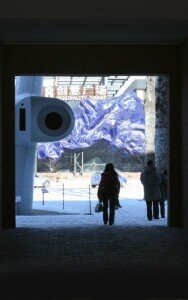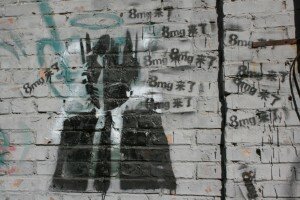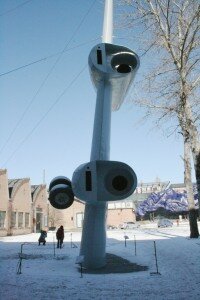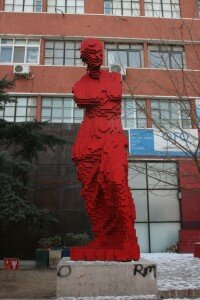At Dashanzi
798, also called the Dashanzi Art District, is Beijing’s premier art community. Since it formed in the early 2000s, a number of Western art dealers and corporate entities have set up shop here, and a few of its first tenants, including Ai Wei Wei, have become a powerful force in the art world. 
My visit to 798 in February 2013 confirmed this description. Walls and light posts are plastered with exhibition billboards and fliers. Weird public art proliferates. For example, in the first three courtyards closest to the entrance, there is: a resin statue of a scorpion, an airplane wing embedded upright in the ground (its engine looking much like an unblinking camera eye) and a 7 foot tall cement man bound in rope, BDSM style. Spray paint stencils and graffiti coat the exteriors of buildings, buses, and signs. Street sellers hock potatoes and fur pelts as fashionable visitors wander in and out of galleries and cafes, snapping photos. In short, the site bears all the tell-tale semiotics of frenzied artistic and commercial production consistent with international art communities like SOHO and Chelsea.
Still,798’s current role—part art-zone, part shopping center—is relatively new. East German architects originally constructed the site as an electronics factory in the 1950s, and until its insolvency in the 1970s, 798 was a paragon of the state-run worker commune. Outside of the storefront facades and the self-consciously asymmetrical, iceberg-shaped gallery at the center of the district (whose presence seems as new as it does out of place), most of the architecture in 798 looks original, and it’s easy to imagine the site as it was 50 years ago.
East Germans in Beijing: Building Factory 718
 The Danshanzi Art District in northwest Beijing, architecturally speaking, is a modest endeavor (perhaps unsurprising for a factory). The site is a rectangular compound arranged on a grid. It is composed of thick, horizontal buildings made of plain red brick. It has unadorned walls dotted here and there with a few windows, arranged in uniform blocks. The avenues are wide and open. The public squares feel tiny and intimate. Pipes and vents of all colors and ages reach between buildings, supported by metal gantries. Some poke up from the ground, releasing steam into the street. In a lot of ways, this is a pretty unassuming space, one that follows its own iterations of style in an absolutely unconscious way. Even today, with its contemporary art veneer, it still looks more like a place where you make or build things rather than sell them.
The Danshanzi Art District in northwest Beijing, architecturally speaking, is a modest endeavor (perhaps unsurprising for a factory). The site is a rectangular compound arranged on a grid. It is composed of thick, horizontal buildings made of plain red brick. It has unadorned walls dotted here and there with a few windows, arranged in uniform blocks. The avenues are wide and open. The public squares feel tiny and intimate. Pipes and vents of all colors and ages reach between buildings, supported by metal gantries. Some poke up from the ground, releasing steam into the street. In a lot of ways, this is a pretty unassuming space, one that follows its own iterations of style in an absolutely unconscious way. Even today, with its contemporary art veneer, it still looks more like a place where you make or build things rather than sell them.
The district is a favorite subject of contemporary articles on urbanization and gentrification because of its shift from an industrial production space to a creative development area, an unusual occurrence in China. The story of 798’s construction, operation, decay, and revival parallels a broader story of changes in the modern urban and cultural landscape of Beijing.
*******************
798 is a smaller subunit of a much larger factory complex called 718. It was one of a number of projects initiated by the Communist government after their victory over the Nationalists and their subsequent consolidation of power in Beijing. It’s part of a Mao Zedongs’s incredibly ambitious proposal to industrialize China, after two decades of civil war and nearly two centuries of political and economic decline.
Mao envisioned a future China that outgunned Britain in steel production and a new modern capital whose sky would be populated with a “forest of smokestacks.” The journalist Jianying Zha notes (somewhat sarcastically) that when Mao came to Beijing, there were only 15 architects there, and less than 5 of them knew how to construct a three-story building.
It was the Soviet Union, initially, that made the realization of Mao’s urban plans possible. Though they may have spitefully  destroyed their coal-mining factories in Manchuria in 1946 to keep them out of Chinese Communist hands, by 1950, they’ve changed their mind. By 1951, there are 156 Soviet projects in the works, in Beijing and across the country.
destroyed their coal-mining factories in Manchuria in 1946 to keep them out of Chinese Communist hands, by 1950, they’ve changed their mind. By 1951, there are 156 Soviet projects in the works, in Beijing and across the country.
Factory 718 would become project number 157, initiated by Premier Zhou Enlai. He requests an additional factory to produce electronic components specifically for the People’s Liberation Army. The Soviets lack the necessary expertise, but they arrange a meeting with their electronics supplier, the head of the East German government, who agrees enthusiastically to work on the project. Between 1954-1964, a total of 300 East German experts traveled to the site to cooperate with Chinese construction workers and engineers, as thousands of tons of materials made their way from Germany to Beijing by way of the trans-Siberian railroad. At its completion in 1957, the “North China Wireless Appliances Friendship Factory” covered 500,000 square meters and had 7 separate operating units.
The East German and Chinese construction groups, with minimal interference from their Soviet overseers, made an excellent team. Both countries understood the necessity of making much out of little; both were in the process of rebuilding and were eager to reboot (or in China’s case, establish) their industrial sector through any means necessary; both worried greatly about the ability to withstand foreign attacks.
The East Germans built 798 with all of these things in mind, and it’s apparent in certain aspects of the architecture. While the Soviet leadership initially disliked the undecorated, sparse German design and demand something more “historical” (whatever that means—most likely something that bears more obviously the mark of Soviet domination through kitschy entablature), the Germans refused; records of their conversations with Soviet and Chinese leadership, luckily, show the detailed case the East Germans made for the particular components of their design.
Consider, for example, the oddly Romanesque-looking arch supports, with their massive interior buttresses, that line the inside of some of the larger factory spaces. (It is an odd effect—the buildings look like they’re leaning backward and resting on their haunches.) Why this odd design? Presumably, because it’s much stronger than walls simply built perpendicular to the ground and topped with a triangular prism of a roof (the Germans repeatedly insist that they’ve designed the factory this way to ensure that it will survive an air raid—something they certainly know a little bit about.)
Consider also the humble type no. 500 red bricks used in every warehouse and wall. This particular type of brick was not available in China, but the East Germans insisted that without it, they could not guarantee the integrity of the design in the event of an 8-magnitude earthquake. To solve this problem, the Germans built factories to make them. (Factories producing factories in an infinitely recursive fashion—this is the ultimate modernist dream.) They then proceeded, according to a former factory worker, to test the psi of every single one. When a 7.8 magnitude earthquake struck the neighboring province of Tangshan a few months before Mao’s death in 1976, one can only assume the German team felt particularly validated.
Reform Follows Function: Ideology and Urban Policy
In the creation of a new Beijing, both construction and destruction were necessary. When Mao moved to transform Beijing into a socialist masterpiece, a “proletariat-peasant metropolis,” his makeover was brutal. The hútòngs, distinctive alleys with dense, infinite recursions of space, were destroyed en mass, as were the city walls and gates; hundreds of teahouses, temples, and residential courthouses (sìhéyuàn) were also systematically bulldozed. Why was this? Jiaying Zha suggests that, from an entirely aesthetic and symbolic perspective, Beijing couldn’t function as the capital of communist nation in its existing state; she calls the city walls, for example, symbols of the “feudalism and claustrophobia” that Mao was trying so desperately to purge from the city. They were too much of a reminder of the old ways, of rigid imperial hierarchies, of out-of-touch emperors and stale customs, of decadence and decline and luxury. The city needed to change because Chinese people needed to change too, in the way that they thought about one another and the way they lived together.
 Architecture and urban planning worked in an advisory capacity here, attempting to engineer social behavior from the top down. There is no better example of this (at least, that still remains intact from this period) than the state-run factories, 718 in particular. Like many other Soviet-built factories of the time, 718 was intended to be an entirely self-contained entity; each unit included residential, commercial, and work-spaces for its respective denizens. This is in contrast to the previous division of space in old Beijing, in which living and commercial quarters were kept distinctly separate. In communist Beijing, the basic of unit of cultural, spatial and social organization was no longer the neighborhood, but the factory.
Architecture and urban planning worked in an advisory capacity here, attempting to engineer social behavior from the top down. There is no better example of this (at least, that still remains intact from this period) than the state-run factories, 718 in particular. Like many other Soviet-built factories of the time, 718 was intended to be an entirely self-contained entity; each unit included residential, commercial, and work-spaces for its respective denizens. This is in contrast to the previous division of space in old Beijing, in which living and commercial quarters were kept distinctly separate. In communist Beijing, the basic of unit of cultural, spatial and social organization was no longer the neighborhood, but the factory.
This is why 718 is more than just a factory. It is supposed to be a site for both work and play, for sleeping and eating, for new communal identities to form and thrive. While the compound has a distinctly utilitarian vibe, its form seems patently aware that its function is not only mechanical, but human too.
*******************
At first, it’s hard to identify just what about the complex (outside of great care put into its construction) makes it seem so livable, so pleasing to look at and walk around in. The original site didn’t have much in the way of decorative effects, save the red Cultural Revolution slogans added to the interior walls in the late 60s. Maybe it’s because the East German design, while sparse and practical, is also incredibly livable, human-sized, and intimate. Rather than trying to overwhelm you with the grand authority of the state (perhaps the goal of Tiananmen Square, a former imperial garden) 798 is trying to amuse and comfort you, to be the proverbial Matissian armchair for the worker at the end of a long and tired day.
Perhaps the best illustration of the designer’s ambition to create a space that is both beautiful and functional (both human and machine, and in that way an ideal “machine for living”) is the silhouette of the factory roof in the main square, often described as “saw-toothed.” These buildings, in addition to a few others within the compound, are capped by a series of what look like sawed-off barrel vaults. The red brick portion of the roof completes about 60 degrees of a circle before it terminates in a slab of paneled glass. From the inside, this forms a gigantic hall, a long wedge-shaped prism that now functions as a gallery space, but was formerly the main factory floor. From the outside, the structures make a scalloped pattern that chunks up the skyline in a pleasing, whimsical way.
This feature is a particularly creative solution to a relatively banal problem. The factory spaces required lots of natural light; the north-facing skylights filter in angled sunlight, bright enough to illuminate a space, not so direct as to overwhelm. It’s hard to imagine, though, that the Germans designed these skylights, which look so much like open-mouthed sea bass, without a hint of humor or pleasure in architectural oddity merely for its own sake.
While all this discussion of form-follows function, the elevation of the worker, and the creation of livable machines might sound familiar, it’s worth pointing out that this structure wasn’t actually designed by the Bauhaus (the progressive German architectural school terminated by the Nazis in 1933). In terms of materials and style, there are few comparisons to be made here. Architects like Mise Van der Rohe were famous for working with volume, and not mass; Van der Rohe defined the quintessential Bauhaus-inspired building as a glass skin hung on a steel frame, plastered with stucco on the inside—glorious and white, radiant and lifted. 798, by contrast, is horizontal and heavy. Its red brick masonry is the definition of mass and not volume. Where contemporary Bauhaus was cinematically stark, Dashanzi is stolidly plain.
Still, one gets the idea that Walter Gropius’ ghost implicitly approves of the project. The structure absolutely fulfills and realizes Gropius’ greatest vision for the Bauhaus (somewhat ironically, outside of a Western European context)—that its architecture would operate in service of a great class transformation. For a time, 798 oversaw such a transition in China.
The Socialist Utopia that was
798 was a total space built by a total state, meant to fulfill completely the requirements of a life. Into this comprehensive environment, then, the most privileged of China’s factory workers and engineers went.
In its first iteration, 798 seems to have been a success, from both a social and economic standpoint. For nearly two decades, 798 served as the model of a centrally-planned, government run, self-contained industrial center. Workers had furnished housing  available at 1/30 the price of their wages; their children enjoyed free public education, and their families had access to some of the best medical and dental care in the country. Grainy black and whites from the 60s show happy workers congregating for group exercise and nurses petting the heads of babies at 798’s daycare center. In 798, recreation also played an important role. The site boasted basketball, volleyball, and soccer teams, literary clubs, swimming pools, a stadium, a theater, a library with books in both Chinese and German, and an orchestra that played revolutionary hymns and Western music. I even saw an image of one man doing an Evil Knievel on a German motorbike.
available at 1/30 the price of their wages; their children enjoyed free public education, and their families had access to some of the best medical and dental care in the country. Grainy black and whites from the 60s show happy workers congregating for group exercise and nurses petting the heads of babies at 798’s daycare center. In 798, recreation also played an important role. The site boasted basketball, volleyball, and soccer teams, literary clubs, swimming pools, a stadium, a theater, a library with books in both Chinese and German, and an orchestra that played revolutionary hymns and Western music. I even saw an image of one man doing an Evil Knievel on a German motorbike.
What was propaganda and what was reality? From an outside perspective it’s hard to judge. 798 was in many ways the ideal exception to the general rule of reorganizational failure and poverty in Communist China. Part of why 798 received such generous resources and became a flagship of model factory life was because it produced some of the most valuable (and top-secret) products in the country. When a U.S. U2 plane was shot down in China in 1962, it was workers at 798 that reverse-engineered electrical components found on board (like an insulator) and began producing them for the PLA and for the North Korean military. (Though this is a bit speculative, some writers suggest that 798 was also where the components of China’s first nuclear bomb were created.)
If indeed 798 was ever the socialist utopia it promised to be, it did not last. While workers at 798, due to the selective and important nature of their trade, were shielded and isolated from many of the effects of the Cultural Revolution (1966-1976) and in particular the Great Famine, a radical shift in economic policy under the reformist and moderate leadership of Deng Xiaoping would knock the factory from its privileged state position. Like many state-run enterprises, 798 (and its larger encompassing unit, 718) was essentially insolvent by the mid 90s; over 2/3rds of the work force had been laid off and only one of the original 7 factories, factory 750, was still operational.
Unsustainable as it was, though, 798 was for the Maoist regime a cultural ziggurat; it did not represent the de facto reality of what the country was or necessary would be, but echoed its highest ideals and aspirations. Perhaps Factory 798 was in some ways a huge performance piece, a “culture zoo” that displayed the ideal version of a Communist system, and that became less and less viable as the country struggled with internal divisions, poverty, and the heinous outbreak of the Cultural Revolution. It was, as so many great artworks are, an exercise in articulating not what a society is, but the way in which it sees itself.
Mao is not the only 20st century world leader to find in modern architecture the promise of social reform on a massive scale. Like many other contemporary modern leaders in Western countries, Mao absolutely believed in the transformative power of spatial planning; unlike modern leaders in the west, he had the state power behind him to compel people to realize his vision, in which material reality, social organization, and national ambition merged into one harmonious society, pointedly directed at the future.
798: Factory and Art
How did 798 shift from its previous life as a model socialist electronics factory to its present iteration, an arts and culture center that garners increasing international attention? There are, of course, many unromantic and incredibly practical reasons for this transition, having to do with such boring and obvious things as real estate markets. Jen Currier and Rene Dekker both note, with a touch of irony, that the same market reforms that consigned factory 718 to obscurity, emptying it of its workers and devaluing its property, are what allowed artists to develop it at relatively low costs into an aesthetic enclave in Beijing. The low per-square foot cost to rent was key. Also important: high availability of light, massive high-roofed spaces that function dually well as studios and exhibition spaces, and the orientation of the district far away from the city center and (at least initially) reasonably far away from the watchful eye of Chinese sensors.
Still, convenience aside, it’s clear from reading descriptions from some of the artists and culture workers who were instrumental in the repurposing of the site that there’s more to it than that. Berenice Angremy (2006) of Thinking Hands, an architectural conservation group in Beijing, summarizes it in this way:
“It was very obvious that this area could be where contemporary culture could develop. It contained an architectural testimony to an industrial past that was absolutely very precious, and that’s why we wanted to have an art district here.”
In China, a generation of artists born in the 30s and 40s worked in the factories alongside their parents and peers; they remember the transition from a state-centered economy to Deng Xiaoping’s socialist market system. They witnessed the end of a shared vision of classless prosperity and a culture that glorified the worker. Small, wonder then, that this same generation of artists continues to be preoccupied with factories as culturally resonant spaces and aesthetic objects. There are several 798 artists, including Sui Jianguo, Huang Rui and Xu Yong, who have worked part of their lives in a factory (Huang at a shoe leather factory, Xu at a needle factory).
 Sui Jianguo in particular has an interesting history. He was the head of the sculpture department when, in 1995, the Central Academy of Fine Arts in Beijing moved from Wangfujing to another electronic component factory nearby. Two of his sculptures are here at 798. The first is a three-tiered red mesh cage with dinosaurs inside, probably from his “Made in China” series. The second one is the Diskobolus. The copy I see tucked away in a back courtyard, acting as a doorstop shows a thinly-smiling Chinese in a business suit winding up to pitch a discus; Sui’s most famous version of the piece, however, currently on exhibition at the British museum, is a stony-faced Greek, nearly a perfect copy of Myron’s ancient sculpture, wearing the iconic Mao suit.
Sui Jianguo in particular has an interesting history. He was the head of the sculpture department when, in 1995, the Central Academy of Fine Arts in Beijing moved from Wangfujing to another electronic component factory nearby. Two of his sculptures are here at 798. The first is a three-tiered red mesh cage with dinosaurs inside, probably from his “Made in China” series. The second one is the Diskobolus. The copy I see tucked away in a back courtyard, acting as a doorstop shows a thinly-smiling Chinese in a business suit winding up to pitch a discus; Sui’s most famous version of the piece, however, currently on exhibition at the British museum, is a stony-faced Greek, nearly a perfect copy of Myron’s ancient sculpture, wearing the iconic Mao suit.
Lately, Sui has been making copies of the suit itself, signifying (by his own admission) that “the Chinese people have not yet taken it off. “
*******************
798 may not longer be the center of experimental avant-garde art and culture in Beijing (that title may go to the districts of Caochangdi and Songzhuang); it may fast become a commercial center for aesthetic commerce and speculation, a hub for the international art community in Beijing, and drive out local talent (indeed it may already have, as climbing rent prices have meant that few artists can afford to have residences there). Still, at the moment it serves a dual purpose, allowing Chinese artists and denizens of Beijing to communicate with a complicated past—part industrial, part idealistic. There’s a historical resonance here that is different from the Forbidden City, so neatly sanitized and so clearly a feature of a distant and far removed era. 798 preserves a past-present, a history still on the heels on contemporary China that haunts the memories of its citizens. It stubbornly carries into the affluent present memories of building industrial Beijing, of the construction of state ideologies and their equally rapid dismantling.






